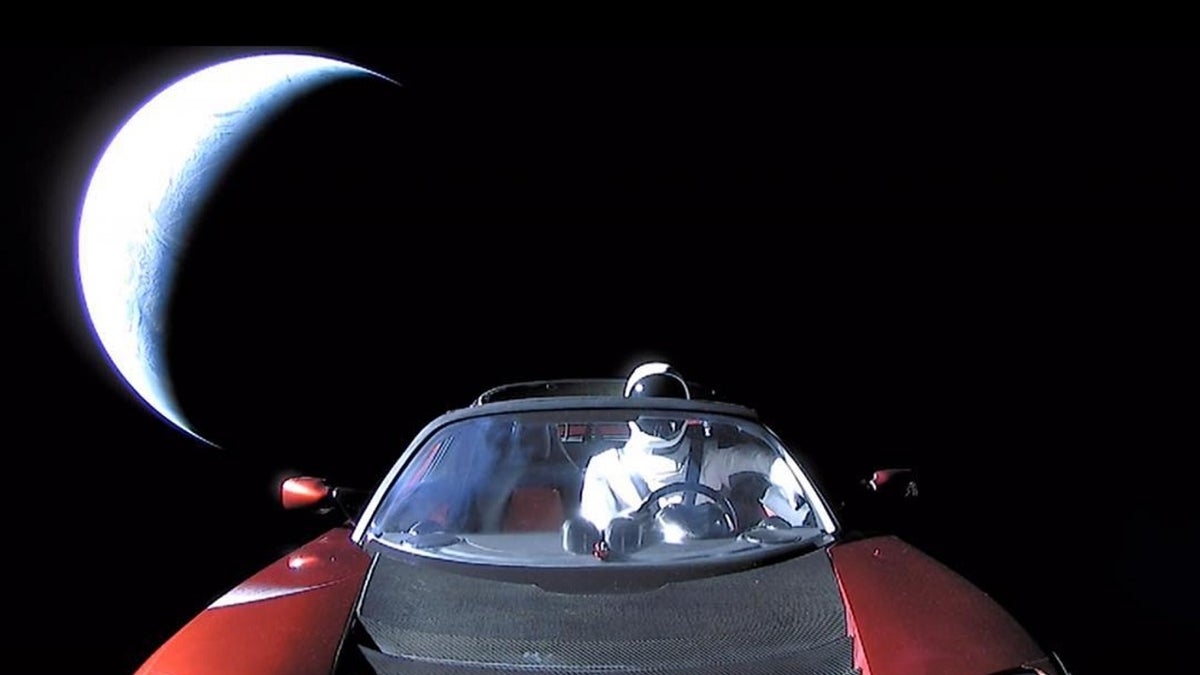
"Last pic of Starman in Roadster enroute to Mars orbit and then the Asteroid Belt," Elon Musk posts on his Instagram. (ELON MUSK/SPACEX)
Elon Musk, the CEO of SpaceX and Telsa, on Wednesday posted the final photograph of the Tesla Roadster that was launched into space on a SpaceX Falcon Heavy rocket and is headed to the asteroid belt.
Musk wrote in the Instagram post, “Last pic of Starman in Roadster en route to Mars Orbit and then the Asteroid Belt.”
Tuesday's launch marked the rocket’s first test flight and is the most powerful rocket since the Saturn V was used in the Apollo missions.
Test vehicles usually carry concrete or steel blocks, but Musk said that would be “extremely boring.”
“We decided to send something unusual, something that made us feel,” Musk was quoted as saying. SpaceX expected the battery in the car to last 12 hours, but it lasted just 4 hours, according to USA Today.
Scientists believe that radiation will tear the car into pieces within a year.
Cameras mounted on the car fed stunning video of “Starman” tooling around Earth, looking something like a NASCAR racer out for a Sunday drive, with its right hand on the wheel and the left arm resting on the car’s door.
A sign on the dashboard read: “Don’t panic!,” while David Bowie’s “Life on Mars?” played in the background at one point. A Hot Wheels roadster was also on the dash with a tiny spaceman on board.
The Falcon Heavy is a combination of three Falcon 9s, the rocket that the company uses to ship supplies to the International Space Station and lift satellites. SpaceX is reusing first-stage boosters to save on launch costs. Most other rocket makers discard their spent boosters in the ocean.
Following the launch, SpaceX was able to recover the two side boosters, landing them safely at Cape Canaveral. However, the central core did not stick the landing on a floating drone ship 300 miles off the Florida coast. Musk said late Tuesday the booster hit the water at 300 mph because it could re-light only one of the three engines needed to land.
Unlike most rockets out there, the Falcon Heavy receives no government funding. The hulking rocket is intended for massive satellites, like those used by the U.S. military and communication companies. Even before the successful test flight, customers were signed up.
“It was awesome, like a science fiction movie coming to reality,” said former NASA deputy administrator Dava Newman, Massachusetts Institute of Technology’s Apollo professor of astronautics. “They nailed it. Good for them.”
Given the high stakes and high drama, Tuesday’s launch attracted huge crowds not seen since NASA’s final space shuttle flight seven years ago. While the shuttles had more liftoff muscle than the Heavy, the all-time leaders in both size and might were NASA’s Saturn V rockets, which first flew astronauts to the moon in 1968.
Containing 27 engines, the rocket had a thrust able to generate more than 5 million pounds, akin to the equivalent of 18 Boeing 747 aircraft. It was able to lift a payload of more than 64 metric tons (141,000 pounds) into orbit, twice as much as the Delta IV Heavy, at one-third the cost, according to SpaceX.
The flight was originally scheduled for 1:30 pm ET, but was pushed back to 3:45 pm ET due to wind shear. It fired from Launch Complex 39A at Kennedy Space Center in Florida.
On the eve of the flight, Musk said the company had done all it could to maximize success. Musk has plenty of experience with rocket accidents, from his original Falcon 1 test flights to his follow-up Falcon 9s, one of which exploded on a nearby pad during a 2016 ignition test.
“I’ve seen rockets blow up so many different ways, so, yeah, it’s a great relief when it actually works,” Musk said after liftoff.
The Associated Press and Fox News' Chris Ciaccia contributed to this report.

